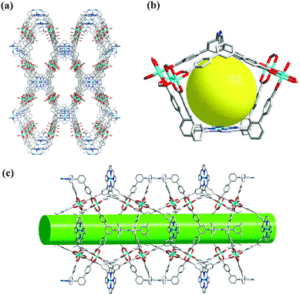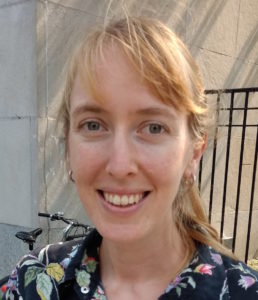Sometimes it feels as though the pinnacle of synthetic achievement is represented by 20 step total syntheses (with 10 contiguous stereocentres and 5 fused rings…). The level of chemical complexity that can be fashioned from simple building blocks is undoubtedly impressive, but amid such feats it is important not to lose sight of the elegance and worth of simple chemistry, especially when it aims to play a part in resolving profound challenges. One such challenge, which will increasingly confront future generations, is how to reduce the load of carbon dioxide in the atmosphere. One solution is to ‘fix’ carbon dioxide by integrating it into chemical building blocks of added complexity in a sustainable way.
The porosity and high surface area of metal organic frameworks (MOFs), a class of three-dimensional coordination networks, proffers them as ideal materials for capture and storage of carbon dioxide. A team of researchers have designed a MOF which consumes carbon dioxide in a different way: by transformation into value-added chemicals. The group have developed a catalytic MOF embedded with lewis-acidic copper centres capable of converting aziridines to oxazolidinones by the addition of carbon dioxide. Oxazolidinones are used as auxiliaries in chiral synthesis, and are structural components of some antibiotics.
The MOF, termed MMPF-10, is a metal-metalloporphyrin framework constructed from a copper-bound porphyrin ring chemically modified to incorporate 8 benzoic acid moieties, generating an octatopic ligand. These carboxylic acids groups form a second complex with copper in situ, termed a ‘paddlewheel’ for its appearance, with the formula [Cu2(CO2)4]. The resulting network contains hexagonal channels measuring 25.6 x 15.6 Å flanked by four of each of the two copper complexes. With 0.625 % of the catalyst at room temperature, 1 bar CO2 pressure, and in a solvent free environment, MMPF-10 catalyses the transformation of 1-methyl-2-phenylaziridine to yield 63% of the product.

Topology of MMPF-10 showing hexagonal channels in a) and c), and pentagonal cavities in b). Turquoise: copper, red: oxygen, grey: carbon, blue: nitrogen.
This work, a simple reaction to prepare oxazolidinones, shows that carbon dioxide can be fixed in specialised synthetic building blocks in a sustainable way. This is the way the first paragraph ended, ‘in a sustainable way’, because the challenge of developing such a reaction is two-fold: it must use carbon dioxide, and the reaction conditions must be sustainable. There will be no beneficial offset if the reaction uses a lot of energy, requires many resources, or generates larges quantities of waste. In this reaction the researchers have remained mindful of developing a mild, solvent-free reaction with low catalyst loading employing an earth abundant metal, reflecting an earnest aim to develop practical and sustainable chemistry.
To find out more please read:
Xun Wang, Wen-Yang Gao, Zheng Niu, Lukasz Wojtas, Jason A. Perman, Yu-Sheng Chen, Zhong Li, Briana Aguila and Shengqian Ma
Chem. Commun., 2018, Advance Article
DOI: 10.1039/c7cc08844b
Zoë Hearne is a PhD candidate in chemistry at McGill University in Montréal, Canada, under the supervision of Professor Chao-Jun Li. She hails from Canberra, Australia, where she completed her undergraduate degree. Her current research focuses on transition metal catalysis to effect novel transformations, and out of the lab she is an enthusiastic chemistry tutor and science communicator.











